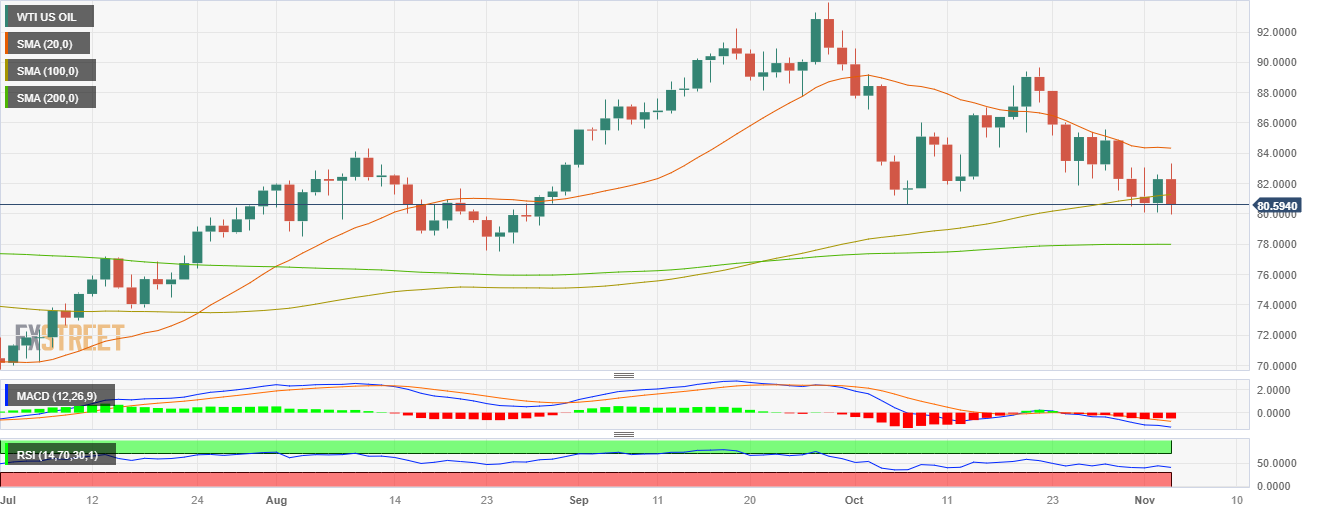- The price of a barrel of WTI fell more than 2%, to $80.70.
- The US reported weak labor market numbers.
- Tensions in the Middle East are easing, which favors the decline in prices.
At the end of the week, the barrel of West Texas Intermediate (WTI) registers heavy losses, mainly due to concerns about the US economy, the largest consumer of oil, after the publication of weak employment and economic activity data. Additionally, as tensions in the Middle East ease, markets are confident that there will be no supply or demand disruptions, which is also contributing to the downward moves.
The US Bureau of Labor Statistics revealed disappointing figures as the US economy’s October job additions fell below expectations by 150,000 versus an expected 180,000 and slowed from its previous figure. revised from 297,000. Additionally, the unemployment rate rose to 3.9%, above the 3.8% forecast, while average hourly earnings rose 0.2% month-on-month, below forecast, and posted a year-on-year increase of 4.1%. In line with the above, if the US continues to reveal that its economy is weakening and that the cumulative effects of monetary policy are taking their toll at this time, oil prices could suffer further falls, since less energy would be demanded to the largest consumer in the world.
On the positive side, as the Federal Reserve (Fed) nears the end of its tightening cycle, it would be beneficial for the WTI price as higher rates tend to be negatively correlated with energy demand. In this sense, the market’s attention shifts to upcoming reports before the next Fed meeting in December, including two additional inflation readings and a jobs report.
WTI levels to watch
Evaluating the daily chart shows a neutral to bearish outlook for WTI, with the balance starting to tip in favor of the bears, although they still have work to do. The Relative Strength Index (RSI) has a negative slope for below its midline, while the Moving Average Convergence (MACD) shows neutral red bars. Furthermore, the price has fallen below the 20-day and 100-day SMA, which appear to be converging towards the $83.00 area for a bearish crossover, which would likely trigger further declines in WTI in the short term.
Support levels: $80.50, $80.30, $80.00.
Resistance levels: $81.60 (100-day SMA), $82.80, $83.50.
WTI Daily Chart

WTI US OIL
| Overview | |
|---|---|
| Latest price today | 80.59 |
| Current daily variation | -1.71 |
| Today’s daily variation | -2.08 |
| Today’s daily opening | 82.3 |
| Trends | |
|---|---|
| daily SMA20 | 84.4 |
| daily SMA50 | 85.98 |
| SMA100 daily | 81.2 |
| SMA200 Journal | 78 |
| Levels | |
|---|---|
| Previous daily high | 82.6 |
| Previous daily low | 80.11 |
| Previous weekly high | 88.12 |
| Previous weekly low | 81.91 |
| Previous Monthly High | 90.88 |
| Previous monthly low | 80.52 |
| Daily Fibonacci 38.2 | 81.65 |
| Fibonacci 61.8% daily | 81.06 |
| Daily Pivot Point S1 | 80.73 |
| Daily Pivot Point S2 | 79.17 |
| Daily Pivot Point S3 | 78.24 |
| Daily Pivot Point R1 | 83.23 |
| Daily Pivot Point R2 | 84.17 |
| Daily Pivot Point R3 | 85.73 |
Source: Fx Street
I am Joshua Winder, a senior-level journalist and editor at World Stock Market. I specialize in covering news related to the stock market and economic trends. With more than 8 years of experience in this field, I have become an expert in financial reporting.







